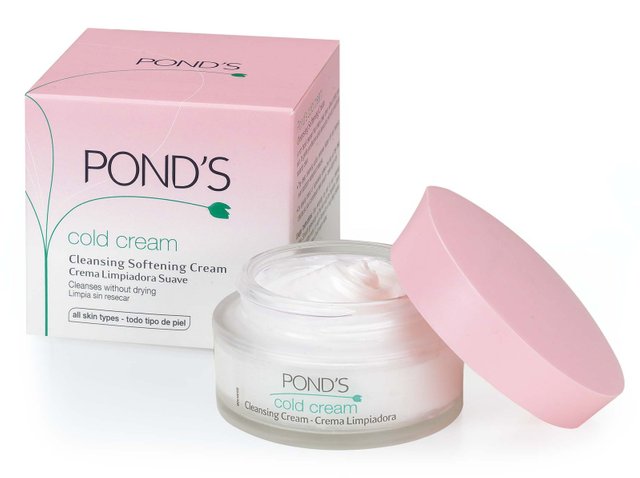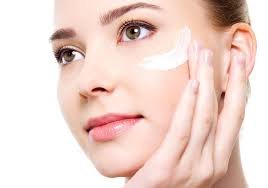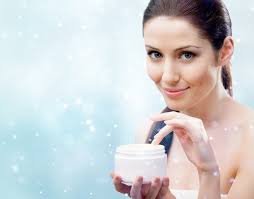POND'S COLD CREAM
Cold Cream

If you've ever asked a wise grandmother about her secret to youthful, smooth skin, you've probably gotten a response like: "Pond's on the face and no worries on the brain." Cold creams, such as Pond's and Noxzema, have been used to cleanse and moisturize skin for many decades — though similar creams have been popular since as early as the second century, when the Greek physician Galen developed a combination of beeswax, rosewater, and essential oils that lent a similar effect to the skin. The unique combination of fat and water in cold cream helps to moisturize, soothe, and soften skin, feeling cold to the touch but extremely refreshing when applied.

According to the 50-plus crowd and modern skin care enthusiasts alike, cold creams can be used for a plethora of purposes: moisturizing dry skin, removing makeup, softening rough patches like elbows and knees, soothing sunburns, washing the face, and even as a shaving cream. While oil-based makeup removers may cause acne flare-ups and makeup-removing wipes can tug on eyelashes, cold creams infuse moisture while completely removing even the toughest of waterproof mascaras. Cream-based products also tend to be more potent than other moisturizers during cold weather, so be sure to pick up a pot of it when your skin feels dehydrated and tight. The chilling effect of these soothing potions even helps to calm wind-chapped cheeks and lips after a walk in blustery Winter weather!

The modern formula for cold cream is, however, quite a different thing to that given in the works of Galen, in point of odour and quality, although substantially the same--grease and water. In perfumery there are several kinds of cold cream, distinguished by their odour, such as that of camphor, almond, violet, roses, &c.[3]
In France, this substance is still known as cérat de Galien ('Galen's Wax'). A copy of the London Dispensatory, edited by Nicholas Culpeper and published in the year 1650 included the following formula for this substance:

Take of white wax four ounces, oyl of roses omphacine a pound; melt in a double vessel, then powr it out into another, by degrees putting in cold water, and often powring it out of one vessel into another, stirring it till it be white ; last of all wash it in rose water, adding a little rose water and rose vineger.
— Nicholas Culpeper (1650), London Dispensatory
An 1814 poem credited to "Dr. Russell" gives the following account of the benefits attributed to cold cream in that day:
WHEN a pot of cold cream to Eliza you send,
You with words to this purpose your present commend;
Whoe'er with this cream shall her countenance smear,
All redness and roughness will strait disappear,
And the skin to a wonder be charmingly clear;
If pimples arise, this will take them away;
If the small-pox should mark you, those marks will decay;
If wrinkled through age, or bad dawbing the face is,
'Twill be smooth in a trice, as the best Venice glass is;
All this, and much more (could I spare time to write it,
Or my pen go as fast, as your lips would indite it)
You affirm of your cream: and I would not abuse it,
But pray tell me one thing—Do you yourself use it.
— Dr. Russell, To A Lady: in imitation of the thirtieth Epigr.am of the fifth Book of Martial

Cold cream now replaces the olive oil with mineral oil or other oils, which are cheaper and slower to spoil, as well as alcohol, glycerin, and lanolin. Beginning in the 1970s, jojoba oil became a common ingredient, used as a substitute of sperm oil from whales. Another common ingredient in modern cold cream is borax, which is also responsible for the whiteness of cold cream. Widely sold brands of cold cream in the United States include Pond's and Noxzema.[citation needed]
Over the centuries, new uses have been found for the product: "As a toilet requisite cold cream is used for softening and cooling the skin after sunburn, as a cleansing cream, to relieve harshness of the skin, etc

The provision of a barrier to protect the skin
This may be a physical barrier or a chemical barrier as with sunscreens
To aid in the retention of moisture (especially water-in-oil creams)
Cleansing
Emollient effects
As a vehicle for drug substances such as local anaesthetics, anti-inflammatories (NSAIDs or corticosteroids), hormones, antibiotics, antifungals or counter-irritants.
Creams are semisolid dosage forms containing more than 20% water or volatile components and typically less than 50% hydrocarbons, waxes, or polyols as vehicles. They may also contain one or more drug substances dissolved or dispersed in a suitable cream base. This term has traditionally been applied to semisolids that possess a relatively fluid consistency formulated as either water-in-oil (e.g., cold cream) or oil-in-water (e.g., fluocinolone acetonide cream) emulsions. However, more recently the term has been restricted to products consisting of oil-in-water emulsions or aqueous microcrystalline dispersions of long-chain fatty acids or alcohols that are water washable and more cosmetically and aesthetically acceptable. Creams can be used for administering drugs via the vaginal route, Triple Sulfa vaginal cream). Creams are also used to treat sun burns.
A cream is a preparation usually for application to the skin. Creams for application to mucous membranes such as those of the rectum or vagina are also used. Creams may be considered pharmaceutical products as even cosmetic creams are based on techniques developed by pharmacy and unmedicated creams are highly used in a variety of skin conditions (dermatoses). The use of the finger tip unit concept may be helpful in guiding how much topical cream is required to cover different areas.
Creams are semi-solid emulsions of oil and water. They are divided into two types: oil-in-water (O/W) creams which are composed of small droplets of oil dispersed in a continuous water phase, and water-in-oil (W/O) creams which are composed of small droplets of water dispersed in a continuous oily phase. Oil-in-water creams are more comfortable and cosmetically acceptable as they are less greasy and more easily washed off using water. Water-in-oil creams are more difficult to handle but many drugs which are incorporated into creams are hydrophobic and will be released more readily from a water-in-oil cream than an oil-in-water cream. Water-in-oil creams are also more moisturising as they provide an oily barrier which reduces water loss from the stratum corneum, the outermost layer of the skin.
We've rounded up eight cold creams that we're sure even Grandma would swear by, so don't let Winter get the best of your skin for another second. Once you try these soothing, classic creams, you'll never go back.